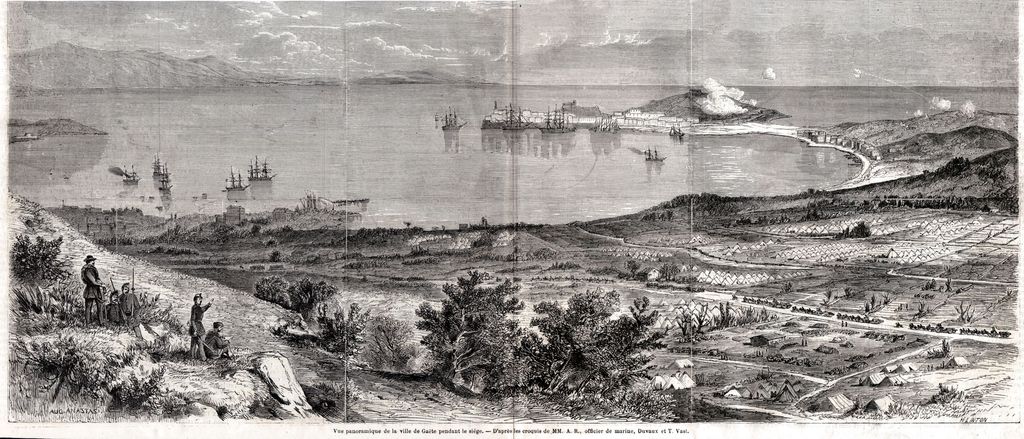The Siege of Gaeta: visiting the relics of a vanished kingdom
by Jason Forbus
History is written by the victors.
Winston Churchill
Despite its long and glorious history, Italy as a country is only 156 years old. Among the key events that brought to the unification of the several kingdoms that dotted the Italian peninsula at the end of the 19th century, the siege of Gaeta, the great stronghold of the former Kingdom of the Two Sicilies, played a major role.
September 6 1860: Garibaldi-led troops arrive in Naples where, also thanks to the connivance of corrupt officials and the heads of Camorra clans, they easily take control of the city to the point where Francis II of Bourbon resolves to leave Naples on board the warship “Il Messaggero”, accompanied by his wife Queen Maria Sofia of Bavaria and his entourage. The decision of leaving the capital of the kingdom without opposing a serious defence was based on two reasons: to save Naples from civil war, and to organize a stronger defence along the Volturno-Garigliano (today, this river separates the Region of Lazio from Campania). In fact, southern military advisors believed that the ranks of Garibaldi-led troops would have broken against the strongholds of Capua and Gaeta. In particular the latter, together with Gibraltar and Malta, was considered the most impressive and impregnable stronghold of Europe.
Fights on the line of the Volturno-Garigliano ended on October 1, 1860. Acknowledging the defeat, in good part caused by the refusal of its Generals to fight, the surviving southern army retreated to Gaeta for one last stand. Earlier in September, most of the fleet under the command of Admiral Louis of Bourbon, Count of Aquila and uncle of Francis II had refused to follow the King. Incredibly, many southern sailors, having seen the attitude of their officers, threw themselves into the sea, preferring death to betrayal. Thus, the only military ships that accompanied the king to Gaeta were the “Parthenope” and the “Delfino”, together with the Spanish ship “Colòn”. The betrayal of southern navy Admirals would prove, together with the technological superiority of the northern army, fatal to Francis II.
The actual siege of Gaeta began on 5 November 1860. Gaeta could count on 300 cannons, only 4 of which smooth-barrelled, whereas the army led by General Cialdini relied on 66 smooth-barrelled cannons and 180 long-range cannons. As the siege grew fiercer, Francis II hoped for reinforcements from allies. Despite receiving some help in the form of supplies from Spain and France, the hopes of the young king were to remain unattended. The siege ended on 13 February 1861, with the resulting annexation of the Kingdom of the Two Sicilies to the Kingdom of Sardinia. At the end of the siege, the assailed forces suffered 826 casualties, 1.400 wounded and 200 missing, in addition to an unspecified number of civilian casualties.
Gaeta Today
Most of the places that characterized this historically relevant siege are still visible today, despite years of neglect and the ill-conceived act perpetrated by one of the city’s mayors, who in the ‘50s ordered the destruction of the remaining bastions to build a seaside promenade. Particularly worth a visit are the ruins of the powder depots on Monte Orlando, whose destruction cost the lives of hundreds and ultimately determined the surrender of Francis II, and the War Memorial of the Kingdom of the Two Sicilies in the recently renovated Basilica of St. Erasmus. St. Francis Temple, built in 1850 by Francis II’s father King Ferdinand II, is another testimony of the reign of Bourbon in Italy and an outstanding example of neo-gothic architecture.
Other sites of historical relevance are the massive Aragonese-Angevine Castle; the Mausoleum of Mark Antony’s fleet commander, Lucius Munatius Plancus; the Sanctuary of the Holy Trinity, mentioned as early as the 11th century and visited, among the others, by St. Francis and Saint Philip Neri; the Sanctuary of Santissima Annunziata, a church and adjacent hospital built in the 14th century and renovated at the beginning of the 17th century in Baroque style; the church of St. John at Sea, initially built outside the old sea walls by Gaeta’s hypate Giovanni IV in the 10th century.


